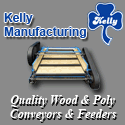 |
 |

|
|
|
New York Ag News Headlines |
 |
Innovation Not Enough: Employee Incentives Help Adopt Technology
New York Ag Connection - 10/20/2017
Your company has devised an improved manufacturing technique and left it up to employees to put it into practice. But, if there is no obvious benefit to those employees, are they going to embrace the new technique?
New research from Columbia Business School explored this question by introducing a new method for cutting waste in the production of soccer balls at factories in Pakistan. The researchers, which include Amit K. Khandelwal, the Jerome A. Chazen
Professor of Global Business at Columbia Business School, found that employees began to use the new method only after receiving a material incentive.
"It turns out there really may be an 'I' in team," said Khandelwal. "When it comes to making soccer balls, and no doubt in other areas of manufacturing, employees want to win just as employers do, but often times they have different ways of keeping
score. This can and should serve as a lesson to firms looking to embrace new technology."
To examine how an innovative technology takes hold, Khandelwal and his colleagues -- David Atkin of the Massachusetts Institute of Technology, Azam Chaudhry and Shamyla Chaudry of the Lahore School of Economics, and Eric Verhoogen of
Columbia's School of International and Public Affairs -- conducted a study in the city of Sialkot, where more than 100 companies turn out 30 million soccer balls a year. The manufacturing process is simple and roughly the same across all companies,
so this industry and city served as an ideal laboratory to examine this question and better understand barriers to technology adoption in manufacturing.
As reported in "Organizational Barriers to Technology Adoption: Evidence from Soccer-Ball Producers in Pakistan," published in the Quarterly Journal of Economics, the researchers acquainted cutters and printers -- workers critical to the process of
producing soccer balls -- with a way to save material, reducing overall production costs by one percent, a significant amount in a business with low profit margins. The new technology produced a savings for the average manufacturer of $1,377 a
month. The method involves cutting pentagon-shaped pieces of material from a sheet of artificial leather in a way that packs the pentagons in the densest pattern known. Mathematicians identified the pattern in a 1990 paper, the authors noted, and a
YouTube video shows the pattern being used to make soccer balls in China, yet only one firm in Sialkot apparently was aware of the pattern.
To test the willingness to adopt the new production method, 35 treatment firms (randomly chosen) were given the equipment to execute the new method, 18 others were given the cash value of the equipment -- about $300 -- and 79 others received
no cash or equipment. To the authors' surprise, the method did not catch on appreciably within the treatment group, despite producing the expected savings in costs and materials. After 15 months, only five of the 35 companies that received
equipment had adopted the method.
"Despite the clear net benefits for nearly all firms," the authors observed, "after 15 months take-up remained puzzlingly low."
In interviews with the firms, the researchers discovered that employees were reluctant to use the new method, even to the point of misinforming bosses about its effectiveness, because of the personal cost born from the new method. It turned out that
while it was less wasteful, the production method was slower, which meant less income for workers, who were typically paid piece rates.
To alleviate this "misalignment of incentives," a second experiment was conducted among the treatment firms that had received the equipment and details of the production method in the first experiment. Two workers at half of those companies (again
chosen at random) were offered bonuses equal to about a month's pay if they could show the owner that they were proficient at using the equipment. Subsequently, after six months, five of them began to use the new technology while none of the
companies in the control group, where the incentive pay plan was not offered, did.
|
 |


|
 |
|
Copyright © 2024 - Farms.com. All Rights Reserved. |
 |
|